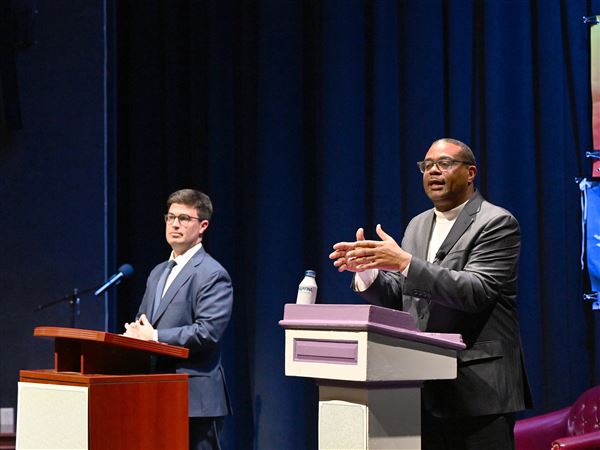After spending nearly three years and hundreds of thousands of dollars on a plan to redevelop the historic produce terminal in the Strip District, Dan McCaffery is running out of patience.
For Mr. McCaffery, CEO of Chicago-based McCaffery Interests, 2017 may be the make-or- break year in his long odyssey to get a deal done to start work. If he doesn’t, he might walk away from the project.
“Everybody knows there’s a moment in time when you have to say you’re done. I’m not a bottomless pit of money,” he said in a recent interview.
Redeveloping the terminal has been a priority for Mayor Bill Peduto since the first day he took office. But as Mr. Peduto enters the final year of his first four-year term, the Strip landmark still sits largely vacant, as his administration struggles to complete an agreement with McCaffery.
McCaffery became involved after the administration struck a deal, one that included a $640,000 settlement fee, with the Buncher Co. to end its involvement with the terminal, which it had an option to buy for $1.8 million. Mr. Peduto disliked Buncher’s proposal to tear down the western third of the building as part of a plan for an office and retail redevelopment, all privately financed.
In the latest effort to strike a deal, the city is proposing a joint venture partnership under which the public would retain an ownership stake in the terminal now owned by the city’s Urban Redevelopment Authority.
It marks the latest chapter in a saga that rivals “War and Peace.” Mr. McCaffery is pitching a $70 million plan to convert the 1,533-foot terminal, a one-time hub for produce wholesalers, into offices, 65,100 square feet of retail anchored by a “merchant shop” and perhaps apartments.
The journey has been filled with delays, failed partnerships and plenty of frustration, as Mr. McCaffery voiced time and again in emails with city officials over the status of the project.
Mr. McCaffery has yet to sign the latest proposal, under which he likely would be the majority owner of the terminal. He said it is still being discussed.
Kevin Acklin, chief of staff to Mr. Peduto and URA board chairman, said a joint venture partnership “would preserve economic value for the public’s investment and allow for a right for the public to reacquire the building if proposed to be sold in the future.”
“The old days where the city taxpayers blindly subsidize developer profits are over,” he said.
As part of the plan, the city has been working with Mr. McCaffery and city Councilwoman Deborah Gross, who represents the Strip, to preserve about a third of the building for a public market, and to dedicate a portion of the storefronts “to be affordable for small, local businesses,” Mr. Acklin said.
Ms. Gross acknowledged that she has been seeking rent breaks for the Society for Contemporary Craft, which occupies space in the far east end of the terminal, and local vendors who may want to be part of the redevelopment.
She argued that a downside of gentrification in a rapidly developing district like the Strip can be the loss of arts organizations and other entities that can’t afford the rent.
With 120,000 square feet of space available in the terminal, she believes it’s appropriate to dedicate some of that for “the kinds of business that we’ve always cherished in the Strip. We’re going to have to be very vocal and clear about preserving the places we value,” she said.
But Mr. McCaffery has raised concerns about possible rent breaks. He said he would make “commercially reasonable efforts” to accommodate such requests. He would make no commitments beyond that.
“I’m not going to be the person who promises something that in order to make that promise come true, the building fails. But I will give my best efforts to whatever I agree to,” he said.
What the developer adamantly has opposed is leasing the building, an option Ms. Gross has suggested in the past. The councilwoman said last week that she, the mayor and Mr. Acklin agree that the public should retain ownership in the terminal, though not necessarily through a lease.
“I do believe that it is a public asset that should be protected,” she said.
Mr. McCaffery said he would not accept any deal that involved a lease. He said the request for proposals he responded to in April 2014 called for the winning developer to own the building outright.
‘Far too many chiefs’
Ownership isn’t the only issue McCaffery has faced in its quest to redevelop the Strip icon, where fruit and vegetable wholesalers hawked fresh produce to restaurants, stores and other high-volume users for decades.
In September 2014, the URA paired McCaffery with Pittsburgh-based Rubino Partners in a shotgun marriage to try to come up with a joint plan for the terminal, only to pull the plug on the arrangement 10 months later without the two developers ever talking.
The URA then teamed McCaffery with another group — Pittsburgh Gateways Corp. — in another attempt to move the development forward. But by the time the URA approved McCaffery’s latest plans for the building last April, Pittsburgh Gateways was out of the picture.
In addition, McCaffery has had to answer to any number of interests with their own ideas on how the terminal should be redeveloped, including the Heinz Endowments and its chairman, Andre Heinz; city planners; community groups; and the URA, as well as Ms. Gross.
Mr. McCaffery’s frustrations with the process and pace of the development are evident in email exchanges with Mr. Acklin and others obtained by the Pittsburgh Post-Gazette through a right-to-know request.
In a Feb. 10, 2016, email to Mr. Acklin, for example, Mr. McCaffery complained that the roles being played by the various parties “have confounded the direction and leadership of the project to an uncomfortable degree.”
“It is a project with far too many chiefs,” he said before suggesting the formation of an advisory board to assure “all interested parties of a thoughtful and participatory process without diluting or should I say further clouding the role of the developer.”
In another email to Mr. Acklin in October, regarding proposed improvements to Smallman Street, Mr. McCaffery said he felt “more like an intruder than a selected developer.”
When the city decided to hire another designer to help with public realm improvements on Smallman, Mr. McCaffery called the move “maddening.” His project manager, Pamela Austin, urged him at the time to give “serious consideration as to how much more time and money we can put toward this project.”
Noting that “we are burning our company’s money to pay consultants” for various services, Ms. Austin continued, “As your project manager I am growing concerned that this project is viable at this rate, without a clear joint strategy, and without us being in charge of our own destiny.”
No apologies
In an interview, Mr. McCaffery, who also has done projects in Chicago, Washington, D.C., Arlington and Alexandria, Va., San Francisco, and Myrtle Beach, S.C., said his experience in trying to redevelop the produce terminal has been “totally unique.”
While accustomed to dealing with community groups in fashioning developments, “This is more on political side than the community side,” he said.
Among those McCaffery has had to deal with are the Heinz Endowments. The foundation, which encouraged Pittsburgh Gateways to partner with the developer, got involved because it did not like McCaffery’s early plans for the terminal, which relied heavily on residential.
“It felt like a misstep. We also were hearing pretty strongly from the community that [the terminal] was a civic space, not a private space,” said Rob Stephany, the Heinz Endowment’s director of community and economic development.
While emails indicate that the foundation has considered contributing at least $4.5 million toward the project, no money has been awarded and none would go for the terminal itself.
Mr. Stephany said the Heinz Endowments cannot give charitable dollars to a private developer. It is “too early to say,” he added, whether it will contribute to the public realm improvements planned on Smallman.
Mr. Heinz, meanwhile, was interested in knowing about McCaffery’s district energy efforts in its Lakeside development in Chicago and “whether we might consider a district energy solution for the” produce terminal, according to an email from Mr. Acklin dated last April 25.

The produce terminal building where millions of dollars in street improvements are planned in the Strip District. Haley Nelson/Post-Gazette
While the foundation has no official role in the development, it has every right to vet the project and offer its suggestions given that it was — and still is — being courted as a potential investor, Mr. Acklin said.
“When you’re pitching a project, any project, to somebody who you’re asking to make that investment, you don’t wait until they write a check to give them a look,” he said.
On the other hand, Mr. Acklin agreed with Mr. McCaffery’s assessment that there may have been too many “chiefs” involved in the project at one point. But he believes that issue has been resolved.
He won’t apologize for the robust engagement that has frustrated the developer at times. He said such engagement is a cornerstone of the type of community-driven development the administration is trying to foster.
“Steamrolling the community and delivering development that doesn’t quite fit with the hearts and minds of this city is a nonstarter with us,” he said.
Deal or walk
Whether the latest plan for a joint venture partnership will produce a deal remains to be seen. Acknowledging the hurdles McCaffery has had to leap, Mr. Acklin conceded that a developer “with less fortitude would have left a long time ago.”
“I think at this point in time we are at the goal line. I believe we are on the cusp of delivering a development that will be great for the residents of the Strip District and the city,” he said.
Likewise, Mr. McCaffery said he and the city are “working diligently” to try to get something done. “I think we’re close but gaps may or may not be closed.”
And if they aren’t, it could be time to walk away.
“I am being patient for good reason. There are well-intentioned people working on this and I respect them,” Mr. McCaffery said. “But for everybody’s sake, there has to be an end to it sometime.”
Mark Belko: mbelko@post-gazette.com or 412-263-1262. Staff writers Rich Lord and Adam Smeltz contributed.
First Published: February 5, 2017, 5:00 a.m.



















